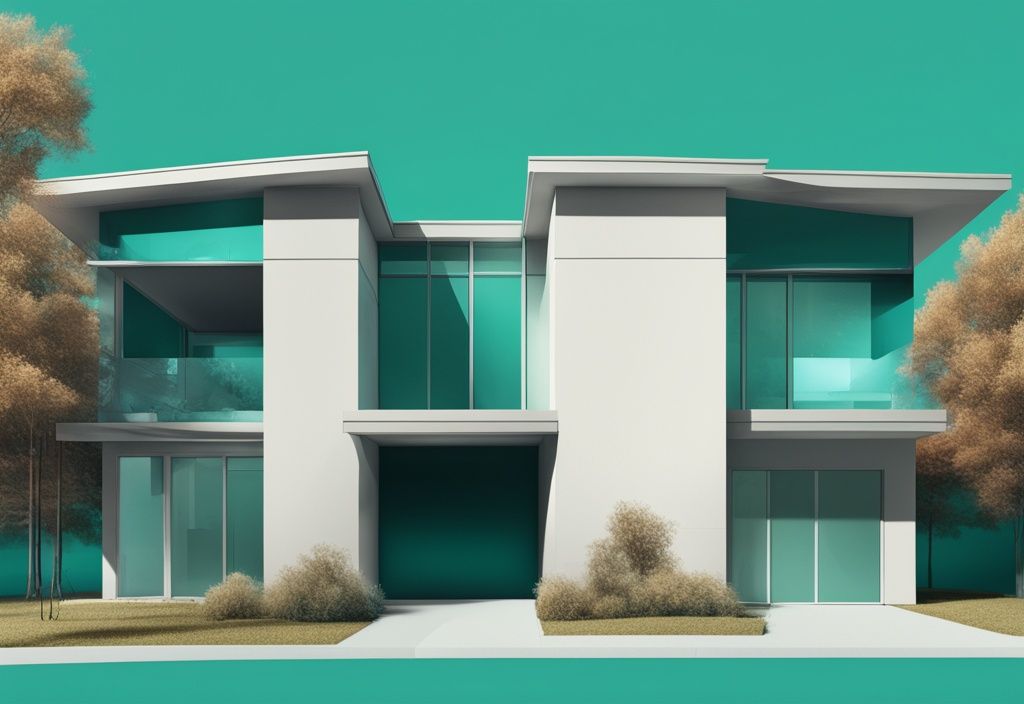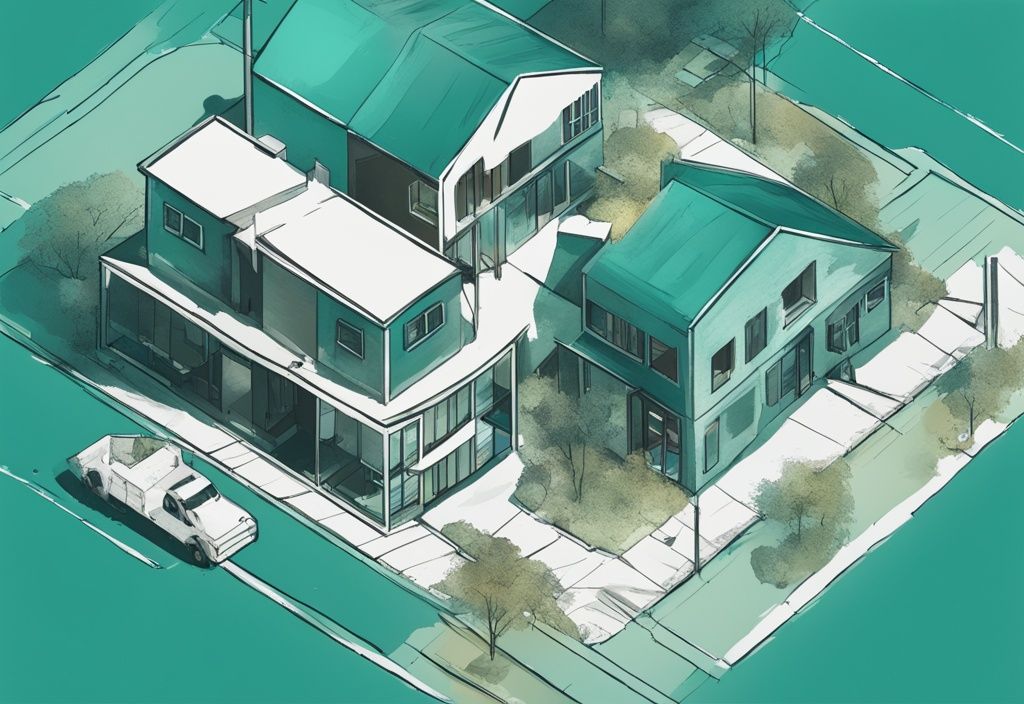Smooth the creases from your brow; there’s no need to struggle with the complex topic of plottage in real estate. Ever wonder why developers are eager to combine smaller parcels of land? It’s not just about size; it’s about the incredible potential of increased property value!
Navigating this can seem challenging, but let’s take a simple, friendly approach. I’ll break down the mystery with easy-to-understand insights and practical advice. This technique, commonly known as plottage, is more than just a jargon-filled strategy, it’s a powerful tool for maximizing your property’s potential.
Dive in and let’s untangle the intricate, yet fascinating, concept of plottage together, and unlock the true power of your property investments. With a bit of friendly guidance, you’ll soon be exploiting this real estate tactic like a pro!
Defining Plottage in Real Estate
Understanding the intricacies of plottage can greatly enhance your grasp of real estate valuation, which takes into account many hard facts about a property such as its location, lot size, amenities, and floor plan. This section delves into the concept of plottage, explaining its significance and differentiating it from assemblage.
The Concept of Plottage
So, what is plottage in real estate? Essentially, plottage refers to the significant boost in value that occurs when smaller parcels of land are combined into a larger one. This increase, often called “plottage value,” stems from the enhanced functionality and potential of the newly enlarged plot.
When smaller bits of land come together, the resultant plot becomes more attractive for lucrative commercial or residential projects, thanks to its expanded size and utility. Imagine combining puzzle pieces to create a bigger, better picture. That’s plottage in action. Plus, the consolidated parcel is legally recognized as a single entity, which smooths out the development process.
Distinction Between Plottage and Assemblage
Although the terms “plottage” and “assemblage” are sometimes used interchangeably, they actually mean different things in real estate. Assemblage is the hands-on process of combining those smaller parcels into one. It’s a bit like gathering ingredients for a recipe; you have to negotiate with multiple property owners and navigate legal procedures to adjust property boundaries.
On the flip side, plottage refers to the increase in value that happens after assemblage is complete. Picture finishing your recipe; the end result is worth more than the individual ingredients. Once assemblage wraps up, the newly created plot experiences a bump in value, known as plottage value. Understanding these distinctions is key to recognizing the steps and benefits involved in transforming smaller parcels into a more valuable development opportunity.
How Plottage Influences Property Value
Plottage illustrates how combining smaller parcels of land into one larger property can significantly increase its value. This process boosts property value because the larger, consolidated parcel can support more ambitious and valuable projects. Such developments might not have been feasible with smaller, fragmented lands.
Process of Value Increase Through Plottage
Plottage allows for greater flexibility and superior development potential, thus enabling more varied and expansive projects. Think of it like piecing together a puzzle—once the fragments come together, the complete picture holds much more value than individual pieces. It’s often the case that the value increment gained from plottage outweighs the costs of assembling the smaller parcels. This makes it a lucrative strategy in real estate, particularly when the land can support larger developments.
The Role of Usability and Development Potential
Larger parcels created through plottage naturally offer increased usability. Imagine it as having a canvas big enough to paint a mural instead of just a sketch. These larger plots can accommodate a range of developments, from commercial complexes and apartment buildings to mixed-use projects. This versatility enhances their market appeal and overall value.
Additionally, bigger plots allow for improved layouts and better access, contributing to higher functionality and desirability. Enhanced usability translates directly into increased development potential. So, the benefits of plottage in real estate are crystal clear.

Influence of Market Conditions and Land Use
Market conditions are crucial when considering plottage. The value realized from a consolidated parcel is maximized when the land use aligns with the current market demands and trends. The concept of “highest and best use” is key here, as it means utilizing the land in its most productive and profitable way.
This is especially essential in urban areas where land is scarce, and demand is high. When plottage is properly aligned with market conditions, it can yield exceptional returns, driven by the high demand for developable land. The idea is to make the land work its hardest for you, transforming potential into profit.
Applying Plottage in Real Estate: Practical Examples
Plottage in Residential Real Estate
Plottage in residential real estate opens doors to exciting development opportunities and can significantly boost property values. Imagine combining a couple of adjacent lots—you’d have more space to work with, which means more housing units and amenities. This extra room could lead to better layouts and richer community features, making the neighborhood even more appealing.
When developers merge these lots, they can create larger, more attractive residential projects. This not only shoots up property values but also draws more market interest. Think of a beautifully planned community that enhances local infrastructure—such developments naturally attract more potential buyers and residents, elevating the entire area’s desirability.
Commercial Real Estate and Plottage
In the commercial real estate world, plottage is a game-changer for creating valuable development opportunities. Picture merging smaller parcels into a bigger plot—it allows for the construction of grand shopping centers, office buildings, or entertainment complexes. Larger plots mean more flexibility for optimized storefront layouts, smoother traffic flow, and a richer customer experience.
By drawing in a mix of businesses—retail, food, service sectors—the overall property value can skyrocket. This diverse blend makes the site more attractive and injects vibrancy into the local economy. Imagine a bustling commercial area where various businesses thrive, collectively boosting the appeal and economic health of the surrounding community.
By understanding and applying the concept of plottage, you’re empowering yourself to make strategic moves in the real estate market that can lead to thriving residential and commercial developments.
Navigating Challenges in Plottage
Combining smaller parcels of land into a larger, more valuable parcel—known as plottage—involves significant legal and cost considerations. The process of adjusting property boundaries and legally consolidating parcels is complex and often requires professional intervention from real estate attorneys, surveyors, and local government entities. These legal steps ensure that the newly combined parcel is recognized as a single piece of property, which is crucial for maximizing its usability and value.
Understanding Legal and Cost Implications
Imagine trying to gather all the pieces of a jigsaw puzzle, each belonging to different people. Now, imagine that some puzzle owners are incredibly hesitant to part with their pieces. That’s what achieving plottage can feel like! It’s about combining smaller parcels of land into one larger, more valuable property—sounds easy, but it’s wrapped in complex legal and cost considerations.
Everything kicks off with the intricate process of adjusting property boundaries and legally consolidating parcels. You’ll definitely need the expertise of real estate attorneys, surveyors, and local government entities here. It might sound daunting, but these pros ensure that your newly combined parcel is recognized as a single entity, boosting its functionality and value.
However, brace yourself for potential high costs. Dealing with property holdouts can be particularly challenging. Some property owners might be reluctant to sell, or worse, they could demand prices that are sky-high compared to the market value. This not only pushes up the total costs but can also drag negotiations on much longer than expected.
And then there’s the regulatory landscape. It’s almost like navigating a minefield with local laws, zoning regulations, and community guidelines. These could impose restrictions that could affect the consolidation process, so staying compliant with legal stipulations is key.
Identifying Potential Market and Regulatory Risks
Let’s talk about the other side of the coin: market and regulatory risks. Plottage isn’t just about combining lands; it’s also about sidestepping the pitfalls that can come your way.

One of the major hurdles you’ll face is dealing with property holdouts. Picture a real estate owner who’s just not in the mood to sell or is bent on demanding an exorbitant price. These cases can seriously delay your plans and inflate your costs, complicating the assemblage process that you’re counting on for successful plottage.
Market risks also play a significant role. Think about how market demand can be a fickle friend. Any downturn can put a damper on the expected rise in value of your consolidated parcel. In real estate, market trends dictate property values, so it’s vital to consider whether your development plans align with the current and future market demand.
Lastly, let’s not forget regulatory risks. Navigating local zoning laws and land use regulations is essential. Any restrictions here can limit what you can do with your newly combined parcel, potentially wiping out some of the benefits of plottage you’re aiming for. And then there’s the community aspect—local residents could oppose changes, wishing to preserve the character or usage of their neighborhood.
There you have it! Moving forward with plottage means being prepared for these challenges and knowing how to tackle them head-on.
Strategies for Successful Plottage in Real Estate
When thinking about how to maximize the value of plottage in real estate, there are several key strategies to keep in mind. Understanding these can significantly enhance the outcome of assembling parcels of land.
Importance of Cost-Benefit Analysis
To truly harness the potential of plottage, a detailed cost-benefit analysis is essential. Think of it like planning a big move: you wouldn’t pack without first considering whether the new place is worth the effort and expense. You need to evaluate market conditions, potential for development, and financial ramifications.
Imagine buying two adjacent plots – you need to ensure the combined value is significantly higher than the sum of the parts. Working with experienced professionals, such as real estate analysts, can offer you these precise estimations. They help you see beyond the immediate financial layout to the long-term benefits, preempting any unexpected financial hurdles that might come your way.
Role of Real Estate Professionals in Plottage
The finesse of an expert touch can make a world of difference in plottage. Picture this: brokers, attorneys, and appraisers becoming your dream team, guiding you through each step. Brokers are your go-to people for identifying and negotiating property acquisitions, making sure you get the best deal. If you’re interested in learning more about how to attract international real estate buyers, it’s important to have a well-rounded strategy. Attorneys come in to manage the legal maze that often accompanies land consolidation, ensuring all legal ducks are in a row. Appraisers give you the clear picture of the assembled parcel’s value, offering a glimpse into the potential benefits. Together, these professionals streamline the entire process, turning your dream project into a reality with a lot fewer headaches.
Significance of Zoning and Land Use Regulations
Think of zoning laws and land-use regulations as the rulebook for your plottage game. Knowing the rules inside out allows you to play smarter, anticipate challenges, and avoid costly mistakes. Zoning laws control how you can use your merged parcel, and staying compliant with local regulations is non-negotiable to dodge legal troubles.
Imagine expecting to build a multi-story building, only to find out your newly merged land is zoned for single-family homes. Being aware of these regulations upfront helps you maximize development potential, ensuring the land serves its highest and best use. Stay ahead by understanding and navigating these rules, turning what could be obstacles into stepping stones for your success.
Conclusion: Maximizing Plottage Value in Real Estate
Understanding What is Plottage in Real Estate
Plottage in real estate is essentially when smaller parcels of land are combined into a larger, unified plot, resulting in an increase in overall value. This is a key concept because a more substantial parcel can accommodate valuable development projects, a strategy beneficial in both residential and commercial real estate.
Enhanced Usability and Development Potential
One of the main perks of plottage is the enhanced usability that a larger parcel offers. Think about it—bigger plots can host more ambitious and diverse projects, whether it’s a commercial complex, apartment building, or mixed-use development. This increased potential is a crucial factor in realizing the added value.
Aligning with Market Demands
Maximizing value from plottage comes down to ensuring that the larger parcel meets current market needs and trends. Using principles of highest and best use can ensure that the consolidated parcel reaches its most productive and lucrative potential. This is especially vital in urban areas where land is scarce and demand is high, presenting some golden opportunities.

Legal and Cost Considerations
Although plottage can significantly boost property value, it does come with challenges. Legal steps to adjust property boundaries and the costs of buying up parcels can be steep. Here, a thorough cost-benefit analysis can help ensure the expected value increase makes these expenses worthwhile.
Role of Professional Expertise
To nail a plottage strategy, involving experienced real estate professionals including brokers, attorneys, and appraisers is key. These experts can tackle the intricate legal and financial details, offering precise cost and value estimates. Their know-how is invaluable for navigating challenges and ensuring the value increase hits its mark.
Zoning and Land Use Regulations
Navigating zoning laws and land use regulations is crucial when dealing with plottage. These rules dictate how the merged parcel can be used, and ignoring them can spark regulatory issues and community pushback. Foreseeing these challenges and planning accordingly can smooth out the development process. Understanding the financial aspects, such as what is earnest money in real estate, can also be crucial in real estate transactions. Overall, incorporating these elements into a thorough strategy can significantly boost the value realized through plottage, making it a powerful tool in the realm of real estate development.
Your Plottage Questions, Answered
What is Plottage in Real Estate? Brief Overview
Plottage in real estate is the increase in property value achieved when smaller land parcels are merged into a single, larger plot. This concept applies to various real estate types, including residential, commercial, industrial, and agricultural properties. By creating a larger, consolidated parcel, the land can support more comprehensive and valuable development projects, increasing its overall worth. Imagine it like piecing together a puzzle; a complete picture is always more valuable and useful than isolated pieces scattered around.
How Do Plottage and Assemblage Differ?
Assemblage is the act of combining smaller parcels of land into a larger one, involving legal procedures and negotiations with property owners. Plottage, on the other hand, refers to the increase in property value resulting from this consolidation. Think of assemblage as the process of baking a bigger cake, while plottage is the delicious taste you get from it. While assemblage deals with merging plots, plottage focuses on the enhanced value achieved post-merger.
Factors That Enhance Plottage Value
Several factors contribute to enhancing plottage value. One primary factor is increased usability since a larger parcel offers more development potential and can accommodate substantial projects.
Additionally, aligning the consolidated parcel with the highest and best use principles, considering market demands, boosts its value. Plus, location-specific factors like land scarcity in urban areas and growth trends significantly influence plottage value, making it more attractive for development.
A bigger, better-positioned piece of land is like upgrading from a studio apartment to a spacious family home. It’s all about what the land can offer once it’s pieced together.
Identifying Plottage Risks
While plottage can significantly increase property value, it also comes with certain risks. Legal and cost challenges are major considerations, especially when dealing with property holdouts or above-market purchase prices.
Market risks, including economic downturns or shifts in demand, can impact the anticipated value increase. Regulatory issues like zoning restrictions and community opposition can further complicate the process, sometimes limiting development potential and delaying projects.
Think of it as planning a big family reunion: logistical hiccups, unexpected costs, and neighborhood complaints can all complicate what you hoped would be a smooth and rewarding gathering.
Strategies for Plottage Success
To achieve plottage success, conducting a thorough cost-benefit analysis is essential to ensure the potential value increase justifies the costs involved.
Engaging real estate professionals like brokers, attorneys, and appraisers is crucial for managing the legal and financial intricacies of the process accurately. Another key strategy is understanding and navigating zoning laws and land use regulations to maximize the development potential of the consolidated parcel.
These steps collectively ensure a smooth plottage process and help in maximizing property value. It’s like setting up a well-organized event: having the right experts and navigating the necessary rules can make your gathering not just successful but memorable. Understanding factors such as external obsolescence in real estate is crucial for long-term planning and success.
Hi, I’m Alex Harper, a real estate expert with over ten years of experience in property management and legal advice. My passion is making the often complicated world of real estate understandable. I share practical tips and simple solutions to help you make better decisions – whether you’re buying a home, renting or just want to learn more about the industry. With my knowledge and experience, I want you to feel well-informed and confident in your real estate projects. Let’s tackle this together!




